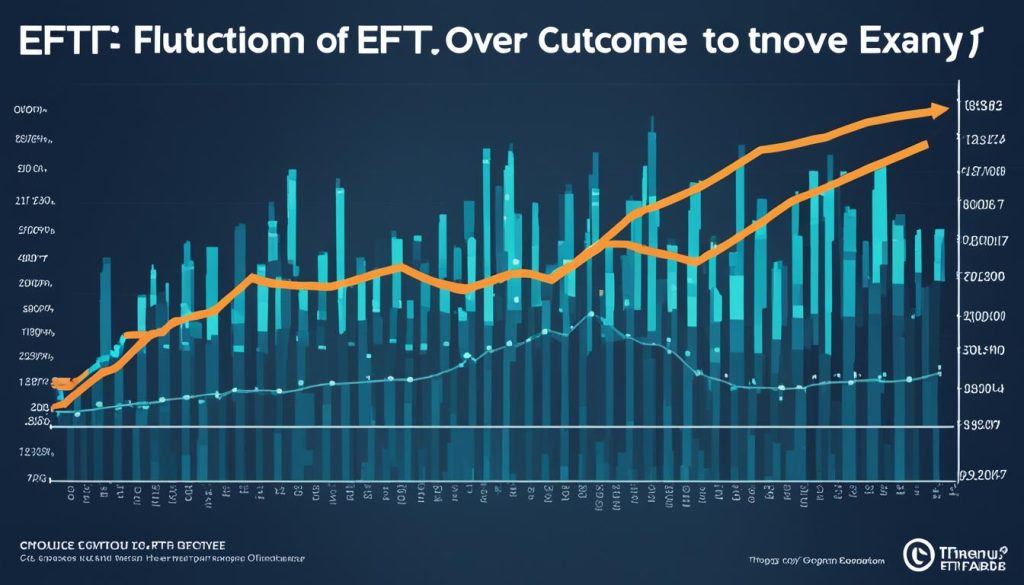The world of investing is always changing, but understanding the basics can help you make smart choices for the future. It’s important to know the difference between investment types and their risks. For beginners, focusing on index funds or ETFs that follow the market is often a good strategy.
Stocks usually give higher returns but come with more risk1. Experts suggest spreading your investments to balance risk and reward. ETFs are great for diversifying, holding from one stock to over 7,000 different ones2. With over 3,000 ETFs at Schwab that don’t charge commission, you have many options for a strong portfolio2.
Key Takeaways
- The investment landscape offers a diverse array of asset classes, each with its own risk and return profile.
- Stocks, bonds, and ETFs are among the most popular investment vehicles, each with their own advantages and drawbacks.
- Diversification is key to managing investment risk and optimizing returns over the long term.
- ETFs provide a convenient and cost-effective way to gain exposure to a wide range of markets and sectors.
- Understanding the basics of different investment options is crucial for building a well-balanced portfolio.
Understanding the Investment Landscape
Investing can seem overwhelming, but knowing about different asset classes and their risks can help. The investment risk ladder sorts investments by how stable they are, from very stable cash to very risky alternative investments.
Types of Investment Assets
Cash holdings, like savings accounts and CDs, are at the bottom of the ladder. They are stable but often don’t keep up with inflation3. Bonds offer a fixed interest rate but their value can go up or down with interest rates.
As you move up the ladder, mutual funds and ETFs offer more variety. Mutual funds combine money from many investors to buy different securities. Some follow indexes and others are managed actively3. ETFs trade like stocks and cover a wide range of assets, giving you broad market exposure3.
At the top, alternative investments like real estate, hedge funds, private equity, and commodities are riskier but could offer higher returns3.
The Investment Risk Ladder
The investment risk ladder shows how risk and potential return are linked. Lower-risk assets, like cash and bonds, are stable but don’t offer much return. On the other hand, riskier investments, such as stocks and alternatives, could bring bigger gains but also more ups and downs3. Spreading your investments across different types can help manage risk and potentially improve your long-term results3.
Knowing about the different asset classes and their risks is key to creating a balanced investment portfolio. This matches your financial goals and how much risk you can handle345.
Equity Exchange-Traded Funds (ETFs)
Equity exchange-traded funds (equity ETFs) let investors explore the stock market with many options. They cover a wide range of stocks, from international to sector-specific and dividend-paying companies6. This means investors can pick ETFs that match their goals and how much risk they can take.
International ETFs focus on companies outside the US6. They give investors a chance to invest in both developed and emerging markets. Sector ETFs, on the other hand, focus on specific industries like tech, healthcare, or energy6.
Dividend ETFs invest in companies that pay dividends6. These funds offer a steady income, which is great for those looking for regular returns. Market-cap index ETFs pick stocks based on a company’s market size. This gives a broad view of the equity market6.
Knowing the differences between these ETF types helps investors make better choices. By mixing different ETF strategies, investors can lower risk and aim for market growth6.
Equity ETFs offer a wide range of options for investors. Whether you want to invest in international markets, specific sectors, or dividend stocks, ETFs make it easy to enter the equity markets6.
| Equity ETF Type | Focus | Key Characteristics |
|---|---|---|
| International ETFs | Stocks in companies headquartered outside the US | Provide exposure to developed and emerging markets, offering diversification beyond the US equity landscape6. |
| Sector ETFs | Specific industries (e.g., technology, healthcare, energy) | Allow investors to target particular areas of the market and potentially capitalize on sector-specific trends6. |
| Dividend ETFs | Companies with a history of paying dividends | Provide a steady stream of income, which can be appealing for investors seeking regular returns6. |
| Market-Cap Index ETFs | Stocks weighted by market capitalization | Offer a broad representation of the equity market and can provide diversified exposure to different company sizes6. |
By exploring the variety of equity ETFs, investors can build portfolios that fit their goals and risk levels. This can improve their investment results6.
Options: Stocks, Bonds, and ETFs
Non-Equity ETFs
ETFs are more than just stocks. They cover various market segments, like foreign and domestic stock indexes, currencies, commodities, and bonds7. This variety lets investors tap into different asset classes, not just stocks.
8 Bond ETFs focus on government, municipal, or corporate bonds for fixed-income returns. Commodity ETFs track raw materials through futures contracts8. Currency ETFs let investors play the foreign exchange market by following a single currency or several.
8 ETFs like the SPDR S&P 500 ETF Trust (SPY) and the iShares Russell 2000 ETF (IWM) see a lot of options trading9. ETFs are traded on an exchange, offering clear pricing and trading info to investors.
| ETF Type | Description | Example |
|---|---|---|
| Bond ETFs | Invest in a portfolio of bonds issued by governments, municipalities, or private companies | iShares Core U.S. Aggregate Bond ETF (AGG) |
| Commodity ETFs | Provide exposure to raw materials like agricultural goods, energy, and precious metals, often through futures contracts | SPDR Gold Shares (GLD) |
| Currency ETFs | Track an index of a single currency or a basket of multiple currencies, allowing investors to participate in foreign exchange markets | Invesco CurrencyShares Euro Trust (FXE) |
8 ETF options settle in shares or cash, unlike index options which settle in cash8. ETF options can be exercised early, requiring the assumption or delivery of shares. Index options don’t have early exercise and settle in cash8. One ETF option contract equals 100 shares of the ETF.
7 To trade options, you need approval from your brokerage firm based on your trading skills7. An options contract has a strike price, an expiration date, and a premium. It’s equal to 100 shares of the underlying security.
“ETFs are considered a good investment for new investors due to their diversification, ease of trading, and low fees.”8
8 ETFs are diversified, which lowers risk by spreading investments across many stocks7. To invest in ETFs, open an online brokerage account, deposit money, and buy ETF shares through the account.
7 Choosing between ETF and index options depends on your investment goals. Index options work well for specific trades and cash outlays. ETF options are better for holding ETF shares8.
Defined-Outcome ETFs: A Tailored Approach
Defined-outcome ETFs, also known as “buffer ETFs,” are a new type of investment tool. They aim to give investors a set range of outcomes over a year10. Unlike regular index funds, these ETFs use options to protect against losses and cap gains10.
To get the desired performance, you must invest at the start and keep your investment through the year10. Some offer a new start every month, giving more chances to join10. These ETFs offer certainty but are pricier than traditional funds10.
Defined-outcome ETFs, or “buffer ETFs,” are getting more popular11. They’re appealing to those who want to invest but also want to protect their money11. They’re similar to Structured Notes, which can be tailored for different risk levels11.
More people are investing in these ETFs as they look for steady returns in a rising market11. These ETFs protect against losses by a certain percentage11.
In 2023, over 40 new defined-outcome ETFs were introduced12. They let investors benefit from market gains up to a certain point while protecting against losses with put options12. There’s a variety of options, from conservative to aggressive, and even monthly series12.
“Fund-of-funds” in the buffered ETF space offer a single investment that covers several ETFs12. They can be managed passively or actively, offering flexibility for investors12. By understanding these ETFs, investors can tailor their investments to meet their goals12.
| Feature | Defined-Outcome ETFs | Structured Notes |
|---|---|---|
| Wrapper | Exchange-Traded Fund (ETF) | Hybrid Investment Product |
| Customization | More Standardized | Highly Customizable |
| Liquidity | Generally More Liquid | May Lack Liquidity |
| Risk-Return Profiles | Limited Range | Wide Range |
| Issuer | ETF Providers | Financial Institutions |
“Defined-outcome ETFs have become an increasingly popular choice for investors seeking a balance between market participation and downside protection in a volatile market environment.”
Conclusion
Investing can seem complex, but knowing about different asset classes helps you make better choices. Stocks might offer high returns over time but can also be risky13. Bonds are generally more stable, providing steady income13. Some bonds, like U.S. Treasuries, are stable and easy to sell.
When picking investments, think about how much risk you can handle, your financial goals, and when you need the money14. Spread your investments across various types to create a balanced portfolio that fits your financial needs15. Consider the fees and minimums of online brokers and robo-advisors, as some have no fees and no minimums.
Your investment strategy should match your personal choices and financial situation. You might prefer index funds and ETFs for a simpler approach or actively manage your investments. Keeping an eye on your risk tolerance and goals will guide you in making smart investment choices.
FAQ
What are the different types of investment assets?
What is the investment risk ladder?
What are the different types of equity ETFs?
What are non-equity ETFs?
What are defined-outcome ETFs?
Source Links
- Exploring Different Investment Options: Stocks, Real Estate, and More
- Types of ETFs
- Investing for Beginners: A Guide to Assets
- Microsoft Word – Understanding stocks, mutual funds, and ETFs REPORT
- Understanding the Basics — What Are Exchange-Traded Funds?
- ETFs vs Stocks: Pros & Cons of Individual Stocks vs. Funds
- Options
- ETF Options vs. Index Options: What’s the Difference?
- Trading Equities, Options, ETFs & Bonds
- Regulatory Notice 22-08 | FINRA.org
- Buffered ETFs vs. Structured Notes: Getting Comfortable with Key Differences and Similarities
- Navigating “Too Much of a Good Thing” via Buffered ETF Fund-of-Funds
- Pros and cons of stocks and bonds
- Stocks, Bonds, and Mutual Funds
- Bonds vs. Stocks: A Beginner’s Guide – NerdWallet


